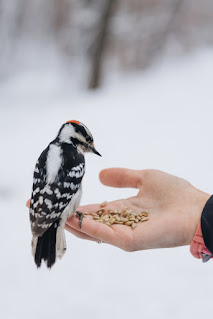The Rhythm of the Woodpecker
A few days ago, I met up with Ruby Slippers, a good friend of Stormie Waters. She told me they had been out riding in Stormie's buckboard on a nice day and found themselves near the Darwin Ranch. Russell Watchtower was practicing his upcoming lecture on woodpeckers.
When the girls told me about it, I was a mite surprised. As we discussed before, woodpeckers showcase the skill of the Master Engineer, so it would be smart for evolutionists to skirt that subject. Instead, they have some more fact-free science to present to the gullible.
 |
| Hand-feeding a Downy Woodpecker, Unsplash / Tevin Trinh |
The sweet melody of songbirds fills the air as the forest wakes up. But there is another familiar voice that joins in the morning songs: woodpecker. The woodpecker doesn’t join in with a voice, but with percussion, drumming a rhythm on trees like a wooden instrument.According to an article posted on ScienceDaily.com, song birds use complex muscle coordination to produce their songs; they learn their song as young birds. The muscle coordination is controlled by a specialized region of the brain, expressed with a marker gene called parvalbumin (PV).
To get with the beat and read the rest, fly over to "Nature's Drummer."